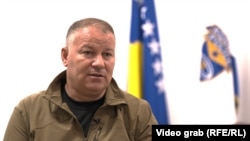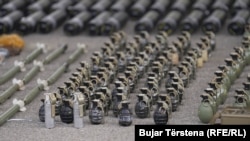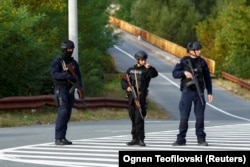PRISTINA -- Authorities in Kosovo are still investigating a deadly incident at a monastery in northern Kosovo on September 24 that resulted in the death of a Kosovar police officer and three of the suspected assailants.
Officials from Kosovar President Vjosa Osmani to Prime Minister Albin Kurti and Interior Minister Xhelal Svecla have alleged Serbian involvement -- a charge that Belgrade denies.
Another official who has alleged involvement by Serbia and even possibly Russia in the incident is Kosovo Police chief Gazmend Hoxha.
On October 4, RFE/RL Balkan Service correspondent Arton Konushevci interviewed Hoxha about what investigators know so far, including possible links between last month's incident and violence against NATO-led KFOR peacekeepers in late May, and the delicate balance between security and normalcy in one of the Balkans' most concerning hot spots.
RFE/RL: How do you assess the security situation in Kosovo, specifically in the north of Kosovo?
Gazmend Hoxha: Regarding the security situation that currently reigns in the northern part of Kosovo, we can say that the situation is calmer compared to the last days and week. The situation there has started to return to normal.
However, the area around the border remains a concern, where it can be seen that the Serbian Army and Serbian security bodies still have a large number of personnel deployed, in addition to artillery and other combat and military equipment.
As for the situation inside Kosovo, we are continuing our work. The operation of combing the terrain is continuing. Also, investigations are under way on many tracks to document what happened and to provide the truth for the judicial process. We are also continuing to exchange information with our security partners, both inside and outside of Kosovo.
Our police units -- along with those [concerned with] public order and the security of [our] cultural and religious heritage -- are in contact with the Banjska monastery, as well as with the residents of the village of Banjska. We are working to get the situation there back to normality to guarantee the safety of our citizens living in that area.
RFE/RL: In terms of the investigations, how far have they progressed in Banjska and what kind of evidence do they involve?
Hoxha: We are currently working along several paths. The first is analyzing all the [seized] weaponry. We are analyzing connections inside the criminal terrorist group itself, the planning…what happened once they entered [Kosovo] and during the confrontation with our special forces and law enforcement officers who were on duty that day.
RFE/RL: Interior Minister Xhelal Svecla has said that there are suspicions of possible Russian involvement in Banjska. Do you have any evidence so far that you can share?
Hoxha: There are several elements. It is known that operations of this level cannot be carried out without strong logistical and political support from security bodies. But we also have intelligence information -- this has already been made public -- that there was such support in the north of Kosovo. "Z" signs were seen constantly. (The letter "Z" has become a symbol of support in Russia and abroad for Russia's full-scale invasion of Ukraine in February 2022, including among many Serbs.) The Northern Brigade and Civil Defense [groups] always used such symbols [in their] slogans. (Those two informal Kosovar Serb groups were banned in June and their members were said by Hoxha and other officials to be among the participants in the Banjska incident.) And there was constant support from groups that fight in Ukraine, as well as people who voluntarily went to fight on the side of Russia in Ukraine. There were also people from Serbia.
What we can confirm so far is that some of the weapons and equipment that have been confiscated are of Russian manufacture. The four-wheeled motorbikes that were confiscated by the Kosovo Police that day are motorbikes that were…produced in Russia. It seems that donations were made to the Serbian Army and police from Russia.
Also, several other weapons that are in the confiscated arsenal are Russian-produced. Currently, this is the factual evidence that we have, as we are working on other evidence. Because it is not an easy investigation. It is an investigation that takes a lot of time and is multidimensional and also requires support and international cooperation with partners from other security services, not only within Kosovo, but also abroad.
RFE/RL: Have these investigations come up with the names of people involved?
Hoxha: They can. We even have names, but we cannot make them public right now.
RFE/RL: How many are there?
Hoxha: The Kosovo Police has managed to identify more than 30 people who were active on the critical day of the 24th [of September].
RFE/RL: The people who were involved, or only from Serbia?
Hoxha: No, I'm talking about the criminal group that was here. We can't talk about other people now -- neither numbers nor their identities.
RFE/RL: In some of the videos you shared, we saw that the attackers were walking as they escaped. Was there an agreement for them to leave? How did they manage to escape?
Hoxha: No, there was no agreement, no communication [regarding] the aim of their release. There were no such attempts either. What happened [is that] we communicated several times asking them to surrender to the Kosovar authorities. They didn't listen and several times repeatedly fired [their weapons]. So, the Kosovo Police made attempts to communicate in order to get them to surrender, but our demands were not accepted and their response was shooting with firearms.
It's impossible to monitor everything that moves on the borders of Kosovo, because the terrain is extremely difficult.
Next, we cooperated with the supervisor of the Banjska monastery…and we also asked through him to communicate with those who were inside so that they would surrender. However, these types of communication didn't work.
Meanwhile, communication about creating a free corridor for someone who killed our colleagues -- we neither had nor could have, because we have principles on which we operate, work, and are established as police. And we don't allow someone who kills a policeman or a citizen of Kosovo…to leave the territory without bearing responsibility for the crime they committed. So, how they managed to leave the monastery and the area of Banjska is [impressive] as that terrain is very rough.
RFE/RL: In the communication you had with the leaders of the monastery, when you asked them to talk with the attackers, what did they tell you? Why didn't they surrender?
Hoxha: [The head of the monastery] said, "I don't have any understanding of their [position], and I'm not sure whether or not there are people inside the monastery." Later, when police approached the monastery, we were confronted with an exchange of fire with armed people. Although one group managed to flee, another group was in the vicinity around the monastery.
RFE/RL: How did all this weaponry enter Kosovo? Why aren't borders better observed?
Hoxha: Kosovo's borders with Serbia demarcate a boundary of 380 kilometers. It's impossible to monitor everything that moves on the borders of Kosovo, because the terrain is extremely difficult. There are many illegal roads that have been opened and continue to be opened from the territory of Serbia near the border with Kosovo. Even now, what we've seen in the last three days -- we've seen machines, excavators, and heavy vehicles that continue to open roads near the border of Kosovo. Also, through an agreement that KFOR has, the Kosovo Police are not allowed to approach to within 1,000 meters of the border.
Then in some places there is the possibility that the moment you get within these 1,000 meters, many other illegal roads branch off -- it's impossible for the Kosovo Police to monitor all those roads. [Weapons] were brought in through an illegal route, which means certain groups were brought in. Then they approached the village of Banjska, in the Banjska Monastery [complex]. This is what happened, in this case.
RFE/RL: How would you rate the cooperation with KFOR in Banjska? Did you expect more?
Hoxha: I can say that we had extremely good cooperation that day. From the early hours of the morning, once I understood what was happening, I was in contact with the commander of KFOR, as well as with the head of EULEX [the EU's civilian peacekeeping] mission, and we coordinated the actions on the ground.
I can say that [it has been] one of the best collaborations we have had during my tenure as [chief] of the police, and even earlier when I was its director of operations. It was an extremely good level of communication and cooperation between us and KFOR.
RFE/RL: Explain to us a little more about that day and the communication at the moment when the attackers were asked to surrender. What advice did you receive or how were you understood?
Hoxha: We communicated with the commander of KFOR, Major General [Angelo Ristuccia]. And the advice was of the nature that you should be careful…you should be careful because it can result in great losses for the police and the state of Kosovo. In this aspect, there were tips. Otherwise, we had support from KFOR in terms of background and EULEX also monitored the incident. They were not directly involved in the operation; the operation was carried out by the Kosovo Police.
RFE/RL: Are there still security risks?
Hoxha: Is there capacity and potential for a threat? There is. This stands. What we are doing [is that] we are working hard to advance communication and cooperation with KFOR, especially around the border with Serbia.
We have increased our police presence there, we have increased our capacities, we are working to close some of those illegal roads and prevent criminal groups, such as this one, from bringing people, weapons, or other materials into the territory of Kosovo. KFOR is doing the same thing.
We have met, seen each other, and are sharing any information we have. We are sharing information with each other and we are also dividing the duties and responsibilities in order to ensure: first, that the border line is secure, and then, second, that the investigators are doing their job and that if there is any particular group that is associated with these terrorists, we will investigate and bring every one of them to justice.
What happened that day was also an attack [against] the citizens of that locality. The residents themselves were at risk.
There are two organizations -- the Northern Brigade and Civil Defense -- which the government of Kosovo has declared as terrorist organizations. We have identified many of the people who are part of these groups, and we know who they are. We are working to understand everyone's role in this incident, as well as in previous incidents and incidents that may happen in the future.
So, we are working to reduce and minimize the risk that they present to our citizens, because these [organizations] not only pose a threat to the Kosovo Police but also pose a threat to the citizens of that area. [Residents there] have been under pressure, blackmail for a long time, forced to protest and oppose every legal decision of the government and the police. (Many Serbs in the four mostly Serb municipalities of northern Kosovo don't recognize Kosovo's independence declaration in 2008 and thus refuse to recognize Kosovar authority.)
We see what pressure they use to force people to come out and achieve their political goals. We've seen that the security system of Serbia uses these people to communicate [and has tried to] blackmail even our young policemen who have recently joined the Kosovo Police, threatening that if they don't leave their jobs, they will get their brothers or sisters dismissed from their jobs and other things.
This makes it a parallel security system that they have on the territory of Kosovo, and then they receive their orders from the government of Serbia, from exponents of the secret services, and from the Serbian police, in order to keep the Serb civilian population in that area under pressure. (Serbia provides financial, administrative, and other support for so-called parallel structures in northern Kosovo, which Pristina regards as illegal.)
RFE/RL: When we talk about special police units, how many are present in the north of Kosovo?
Hoxha: The special police units are there to the extent that they are needed. We currently have had a reduction in the presence of our special units there due to an agreement between the government of Kosovo and the negotiators of the European Union.
However, after the attack on September 24, the police presence has increased. In particular, we have border police units, then also in some strategic areas that we think might be targets and might be very important to guarantee security, we have a presence there. But not to the extent that is trumpeted by the government of Serbia.
We have a police presence of special units to the extent that we can guarantee the safety of our strategic interests in that area and also the safety of our citizens in that area. However, the presence of our special units even on the day when the attack took place was not as much as was trumpeted. That is, a limited number of our special units were the ones who carried out the operation on September 24, not a very large number. We have professionals who did their job.
Likewise, the first police units that joined the operation did a great job. In fact…the [regular police] units were the ones that encountered the attack, which killed our colleague, the youngest hero of Kosovo, Afrim Bunjaku. (Kosovar President Osmani posthumously awarded Bunjaku "Hero of the Nation" status on September 25.)
Then the border police units, which supervise the border in that area, went and retrieved the body of our deceased colleague and the other wounded colleagues and were constantly hit with unrelenting attacks with heavy weapons [and] explosives.
The first attack, against our colleague, in which our hero Afrim Bunjaku was killed, was with explosives: It was an improvised mine and it was set off with detonators from a distance. At the moment our colleague approached the barricade to see what was happening -- whether it was an accident or a barricade -- [the mine] exploded and our colleague was killed and other colleagues were injured. Then [the perpetrators] started shooting from all kinds of weapons at the police -- as you saw in the video that was shown two or three days ago in Mitrovica -- when the minister [Svecla] and I presented it.
RFE/RL: When we talk about the weapons that were found, are they similar [to those used] when KFOR members were attacked [amid protests by local Serbs in Zvecan on May 29]?
Hoxha: There is a large amount of weapons, which have now been seized, very heavy weaponry. That is, it is a military arsenal, which could do tremendous harm to our country, its citizens, and anyone who would use it. Yes, there is a connection between this weaponry that has now been seized and the bombs that were used in the attack on KFOR on May 29.
There is a similarity, because they are the same structures that attacked KFOR on the 29th [of May]. They…also left whole vehicles, ammunition depots, and weaponry ready to attack the Kosovo Police and other bodies of our state, as well as the international presence of KFOR and EULEX.
RFE/RL: How do you plan to approach the Serb community, given that its members in some areas, such as Banjska, say they are afraid.
Hoxha: We can guarantee that the goal of the Kosovo Police is not to threaten, to blackmail, to intimidate our citizens. They are citizens of this country and we have an obligation, and we do this work willingly to serve them and guarantee their safety every day and more.
We have already withdrawn some special forces from the village of Banjska, [and] we have replaced them with a rapid reaction unit, which is a reduced unit in terms of the level of readiness, preparation, and equipment. Also, we have sent our law enforcement officers to communicate with both the citizens and the priest of the monastery there, and our goal is to communicate with them as soon as possible.
You know that we also had some new [recruiting] competitions only for minorities, in this case more members of the Serb community, to join the Kosovo Police. We managed to [recruit] around 79 members: 49 of them were Serbs and others -- Bosniaks, Ashkali, Roma -- who are assigned to work in the northern part of Kosovo.
From the moment we started working and came into office, the pressure started directly from the government of Belgrade and its exponents within Kosovo for [non-ethnic Albanian officers] to leave their work. We are doing our best. We still have a new police job-opening in process, we are still hiring Serb policemen who will serve the community where they are there, because maybe it will be easier, they will be more acceptable, they will find it easier to communicate, because they know the language and all that.
We continue to communicate. We will use all local security mechanisms to activate and then communicate with everyone who is there so that the Kosovo Police is acceptable and our role there is well-understood.
We don't just intend to work with special forces there, we intend to work with law enforcement. But because of the possibility of an attack like the one on the 24th [of September], we are obliged to have special forces police from time to time to provide support to police officers who may be at risk. But not only police officers, because what happened that day was also an attack [against] the citizens of that locality. The residents themselves were at risk.













